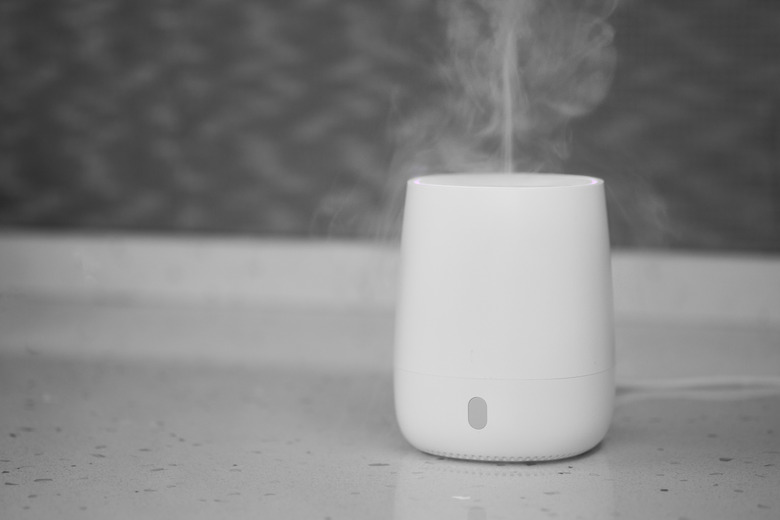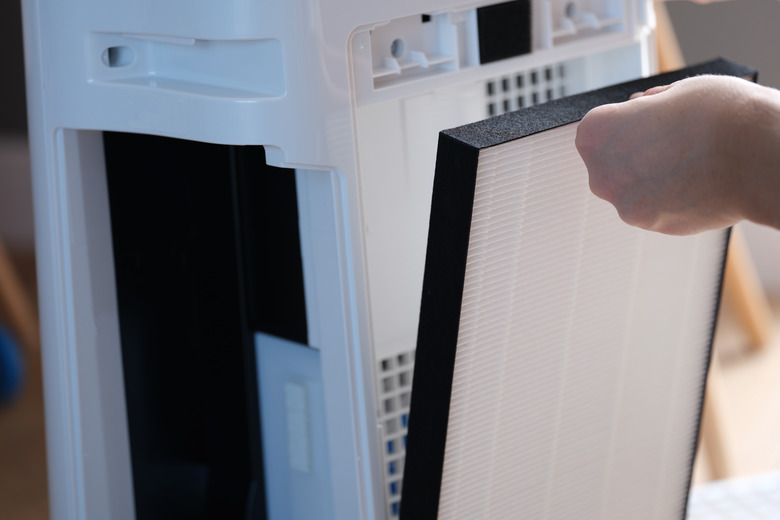Why Is My Humidifier Leaving White Dust And How Can I Fix It?
We may receive a commission on purchases made from links.
A humidifier pumps moisture into the air so your home can fall in the ideal relative humidity range of 30 to 50 percent. If it's any lower, you might notice excessive static, peeling wallpaper, and paint cracks in the space around you. Your body doesn't fare well in dry air either. Cracked lips, skin irritation, exacerbated allergies, and respiratory illness are all possible symptoms of too much time spent in low humidity.
A humidifier remedies these frustrating dry air problems. But better humidity doesn't always equal better air quality. Ultrasonic and impeller humidifiers, also called cool mist humidifiers, can spread minerals in the water through the air, resulting in chalky, filmy humidifier white powder or dust collecting on the surfaces throughout your home. Some of these white dust particles can also end up in your lungs. With some simple adjustments, you can easily get rid of the white dust without giving up on your preferred humidity level.
How to Eliminate White Mist From Your Humidifier
How to Eliminate White Mist From Your Humidifier
Certain humidifiers, particularly impeller and ultrasonic humidifiers, use unfiltered water directly from their water reservoirs. That means if you have hard water, the high mineral content will show up as white dust after the water vapor settles. These are the best ways to keep humidifying your home without collecting humidifier white dust.
Fill Your Humidifier With Distilled Water
Perhaps the easiest way to get rid of white dust mineral buildup is to stop filling the water tank with hard water from the tap. Distilled water contains less mineral content and won't project as much magnesium and calcium, the culprits of white dust from the humidifier, into the indoor air. Here's how to use distilled water in a humidifier:
- Turn off and unplug the humidifier.
- Remove the water tank and give it a good cleaning with disinfectants or a small amount of bleach. Any scale buildup on the tank surface could result in more white dust in your home.
- Rinse the water tank with tap water and dry it with a clean cloth.
- Fill the water tank with distilled water to the fill line. Avoid bottled waters that are labeled as mineral, spring, or artesian. Those types of water will not have the lower mineral content that you're looking for.
Tip
Avoid using harsh chemicals to clean the humidifier. These chemicals will end up in the air you breathe. The United States Environmental Protection Agency recommends cleaning the water tank surface with a 3 percent solution of hydrogen peroxide.
Use a Demineralization Cartridge
Demineralization cartridges can remove the lime, magnesium, and calcium found in tap water so that there's no need to buy special water for the humidifier. Many ultrasonic and impeller humidifiers come with manufacturer recommendations for demineralization cartridges that work with specific models.
However, the EPA warns that results will vary when using this option. If the mineral content in your water is extremely high, a demineralization cartridge may not prevent all of the white dust emitting from the humidifier. This also may not be cost effective when compared with simply buying distilled water. Here's how to use a demineralization cartridge in the humidifier.
- Check your owner's manual for specific demineralization cartridge product recommendations. This is important because not all cartridges will work with all humidifiers.
- Read the packaging instructions on the demineralization cartridge carefully. You may need to soak the cartridge in water for about 10 minutes before placing it in the humidifier.
- Turn off and unplug the humidifier.
- Remove the humidifier tank and unscrew the cap or lid. Clean the tank if it has any residue or buildup.
- Fill the tank with water. Tap water is fine to use with the demineralization cartridge.
- Drop the cartridge into the tank, replace the cap, and fit the tank back in place.
- Replace the demineralization cartridge as needed. Typically, cartridges need to be replaced after 30 to 40 humidifier fillings. However, if you notice that the white dust returns before 30 refills, it's likely that your tap water has very high mineral content, and the cartridge is struggling to filter it out. In this case, either change the cartridge more frequently or switch to distilled water.
Use an Evaporative or Warm Mist Humidifier
An evaporative humidifier is different from other cool mist types in that it uses a filter or evaporative pad and a fan to deliver the mist into the room. The filter wicks water from the reservoir, while the fan blows air through the filter and out of the unit. The key advantage of this system is that the filter traps minerals from the water, effectively preventing the white dust problem. The main disadvantage of evaporative humidifiers is maintenance and cost: The filter or pad must be replaced periodically.
Another type of humidifier that disperses very little mineral content into the air is a warm mist humidifier, also called steam humidifiers or vaporizers. Warm mist humidifiers heat the water to create steam, which rises into the air without the aid of a fan. Steam, like distilled water, contains few minerals. The steaming process also does a lot to purify the water, reducing bacteria and other potential contaminants. On the downside, warm mist humidifiers use a lot more energy than cool mist models, and they can make a small room uncomfortably steamy. Most importantly, the presence of hot water makes warm mist units unsafe to use around small children.

